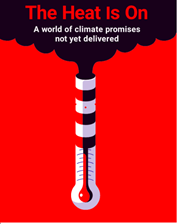Emissions Gap Report 2021
- 27 Oct 2021
On 26th October 2021, the United Nations Environment Programme (UNEP) has released ‘Emissions Gap Report 2021’.
- The Emissions Gap Report 2021: The Heat Is On - is the 12th edition in an annual series that provides an overview of the difference between where greenhouse emissions are predicted to be in 2030 and where they should be to avert the worst impacts of climate change.
About Emissions Gap Report
- The Emissions Gap Reports are annual science-based assessments of the gap between countries' pledges on greenhouse gas emissions reductions and the reductions required to deliver a global temperature increase of below 2°C by the end of this century.
The Report in Brief
Current Status of Emission
- With climate change intensifying and scientists warning that humanity is running out of time to limit global warming to 1.5°C over pre-industrial levels, 2021 has been a fraught year for the planet.
- The Emissions Gap Report 2021 shows that new national climate pledges combined with other mitigation measures put the world on track for a global temperature rise of 2.7°C by the end of the century. That is well above the goals of the Paris climate agreement and would lead to catastrophic changes in the Earth’s climate.
- Global warming at the end of the century is estimated at 2.7°C if all unconditional 2030 pledges are fully implemented and 2.6°C if all conditional pledges are also implemented. If the net-zero emissions pledges are additionally fully implemented, this estimate is lowered to around 2.2°C.
Other Adverse Findings
- Emission bouncing back to pre-COVID Levels: Following an unprecedented drop of 5.4 per cent in 2020, global carbon dioxide emissions are bouncing back to pre-COVID levels, and concentrations of GHGs in the atmosphere continue to rise.
- Mitigation Pledges Insufficient: New mitigation pledges for 2030 show some progress, but their aggregate effect on global emissions is insufficient.
- G20 Members not on Track: As a group, G20 members are not on track to achieve either their original or new 2030 pledges. Ten G20 members are on track to achieve their previous NDCs, while seven are off track. Few of the G20 members' NDC targets put emissions on a clear path towards net-zero pledges. There is an urgent need to back these pledges up with near-term targets and actions that give confidence that net-zero emissions can ultimately be achieved and the remaining carbon budget kept.
- Ambiguities in Net-Zero Emissions Pledges: A promising development is the announcement of long-term net-zero emissions pledges by 50 parties, covering more than half of global emissions. However, these pledges show large ambiguities.
- Emissions Gap Remains Large: Compared to previous unconditional NDCs, the new pledges for 2030 reduce projected 2030 emissions by only 7.5 per cent, whereas 30 per cent is needed for 2°C and 55 per cent is needed for 1.5°C.
- Low-Carbon Transformation missing in COVID-19 Fiscal Rescue and Recovery Programmes: The opportunity to use COVID-19 fiscal rescue and recovery spending to stimulate the economy while fostering a low-carbon transformation has been missed in most countries so far. Poor and vulnerable countries are being left behind.
What need to be done?
- To keep global warming below 1.5°C this century, the aspirational goal of the Paris Agreement, the world needs to halve annual greenhouse gas emissions in the next eight years.
- If implemented effectively, net-zero emissions pledges could limit warming to 2.2°C, closer to the well-below 2°C goal of the Paris Agreement.
- The reduction of methane emissions from the fossil fuel, waste and agriculture sectors could help close the emissions gap and reduce warming in the short term.
- Carbon markets could also help slash emissions. But that would only happen if rules are clearly defined and target actual reductions in emissions, while being supported by arrangements to track progress and provide transparency.





